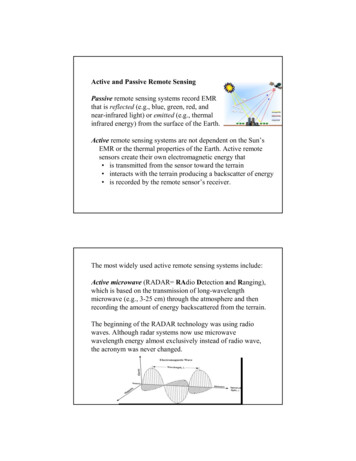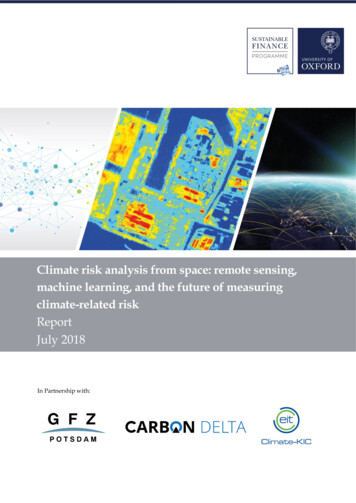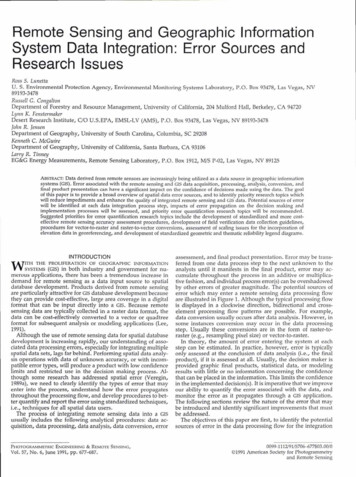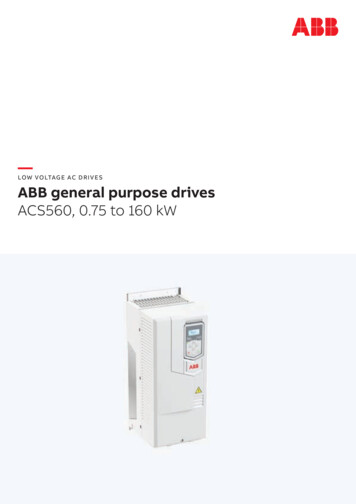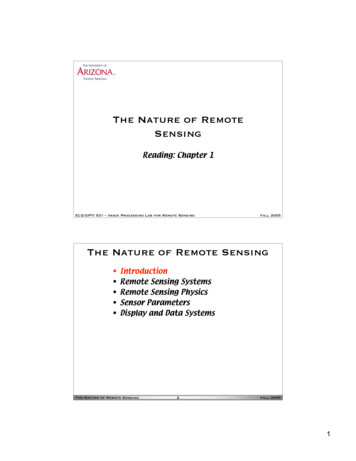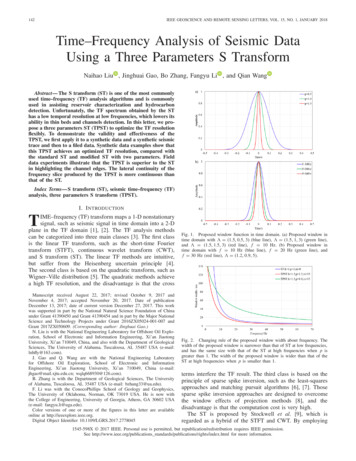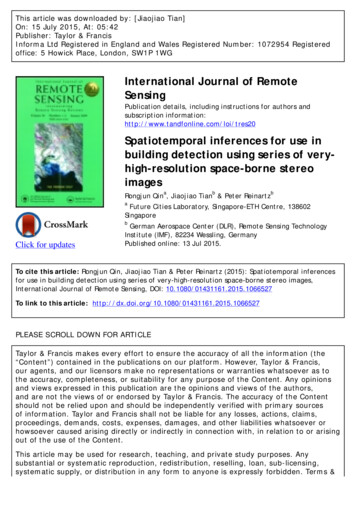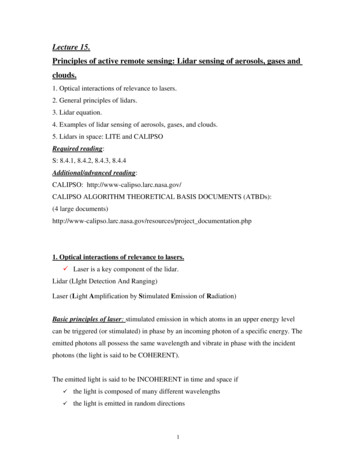
Transcription
Lecture 15.Principles of active remote sensing: Lidar sensing of aerosols, gases andclouds.1. Optical interactions of relevance to lasers.2. General principles of lidars.3. Lidar equation.4. Examples of lidar sensing of aerosols, gases, and clouds.5. Lidars in space: LITE and CALIPSORequired reading:S: 8.4.1, 8.4.2, 8.4.3, 8.4.4Additional/advanced reading:CALIPSO: http://www-calipso.larc.nasa.gov/CALIPSO ALGORITHM THEORETICAL BASIS DOCUMENTS (ATBDs):(4 large es/project documentation.php1. Optical interactions of relevance to lasers.9 Laser is a key component of the lidar.Lidar (LIght Detection And Ranging)Laser (Light Amplification by Stimulated Emission of Radiation)Basic principles of laser: stimulated emission in which atoms in an upper energy levelcan be triggered (or stimulated) in phase by an incoming photon of a specific energy. Theemitted photons all possess the same wavelength and vibrate in phase with the incidentphotons (the light is said to be COHERENT).The emitted light is said to be INCOHERENT in time and space if9the light is composed of many different wavelengths9the light is emitted in random directions1
9the light is emitted with different amplitudes9there is no phase correspondence between any of the emitted photonsProperties of laser light:9Monochromaticity9Coherence9Beam divergence:All photons travel in the same direction; the light is contained in a very narrowpencil (almost COLLIMATED), laser light is low in divergence (usually).9High irradiance:Let’s estimate the irradiance of a 1 mW laser beam with a diameter of 1 mm. Theirradiance (power per unit area incident on a surface) isF P/S 1x10-3 W/((1x10-3 m)2/4) 1273 W/m29 Elastic scattering is when the scattering frequency is the same as the frequencyof the incident light (e.g., Rayleigh scattering and Mie scattering). Inelasticscattering is when there is a change in the frequency.2
Optical interactions of relevance to laser environmental sensing Rayleigh scattering: laser radiation elastically scattered from atoms or moleculeswith no change of frequency Mie scattering: laser radiation elastically scattered from particulates (aerosols orclouds) of sizes comparable to the wavelengths of radiation with no change offrequency Raman Scattering: laser radiation inelastically scattered from molecules with afrequency shift characteristic of the molecule Resonance scattering: laser radiation matched in frequency to that of a specificatomic transition is scattered by a large cross section and observed with no changein frequency Fluorescence: laser radiation matched in frequency to a specific electronictransition of an atom or molecule is absorbed with subsequent emission at thelower frequency Absorption: attenuation of laser radiation when the frequency matched to theabsorption band of given moleculeTypes of laser relevant to atmospheric remote sensing : solid state lasers (e.g., ruby laser, 694.3 nm) gas lasers (e.g., CO2, 9-11 µm) semiconductor lasers (GaAs, 820 nm)2. General principles of lidars.There are several main types of lidars:Backscatter lidars measure backscattered radiation and polarization (often called theMie lidar)DIfferential Absorption Lidar (DIAL) is used to measure concentrations of chemicalspecies (such as ozone, water vapor, pollutants) in the atmosphere.3
Principles: A DIAL lidar uses two different laser wavelengths which are selected so thatone of the wavelengths is absorbed by the molecule of interest while the otherwavelength is not. The difference in intensity of the two return signals can be used todeduce the concentration of the molecule being investigated.Raman (inelastic backscattering) Lidars: detect selected species by monitoring thewavelength-shifted molecular return produced by vibrational Raman scattering from thechosen molecules.High Spectral Resolution Lidar (HSRL) measures optical properties of the atmosphereby separating the Doppler-broadened molecular backscatter return from the unbroadenedaerosol return. The molecular signal is then used as a calibration target which is availableat each point in the lidar profile. This calibration allows unambiguous measurements ofaerosol scattering cross section, optical depth, and backscatter phase function (see S8.4.3).Doppler lidar is used to measure the velocity of a target. When the light transmittedfrom the lidar hits a target moving towards or away from the lidar, the wavelength of thelight reflected/scattered off the target will be changed slightly. This is known as aDoppler shift - hence Doppler Lidar. If the target is moving away from the lidar, thereturn light will have a longer wavelength (sometimes referred to as a red shift), ifmoving towards the lidar the return light will be at a shorter wavelength (blue shifted).The target can be either a hard target or an atmospheric target - the atmosphere containsmany microscopic dust and aerosol particles which are carried by the wind.Lidars compared to radars: Lidar uses laser radiation and a telescope/scanner similar to the way radar usesradio frequency emissions and a dish antenna. Optically thick cloud and precipitation can attenuate the lidar beam, but radarsignals can penetrate heavy clouds (and precipitation).4
In optically clear air, radar return signals may be obtained from insects and birds,and from air refractive index variations due to humidity, temperature, or pressurefluctuations. Lidar beam divergence is two to three orders of magnitude smaller compared toconventional 5 and 10 cm wavelength radars. The combination of the short pulse (of the order of 10-8 s) and the small beamdivergence (about 10-3 to 10-4 radiant) gives a small volume illuminated by a lidar(about a few m3 at ranges of tens of km).3. Lidar equation.In general, the form of a lidar equation depends upon the kind of interaction invoked bythe laser radiation.Let’s consider elastic scattering. Similar to the derivation of the radar equation, the lidarequation can be written asRC h kbPr (R) 2exp( 2 ke (r′)dr′)R 2 4πo[15.1]where C is the lidar constant (includes Pt, receiver cross-section and other instrumentfactors);κb/4π (in units of km-1sr-1) is called the backscattering factor or lidar backscatteringcoefficient or backscattering coefficient;κe is the volume extinction coefficient; and tp is the lidar pulse duration (h ctp)¾ Solutions of the lidar equation:In general, both the volume extinction coefficient κe and backscattering coefficient κb areunknown (see Eq.[15.1])It is necessary to assume some kind of relation between κe and κb (called theextinction-to-backscattering ratio)5
EXAMPLE: Consider Rayleigh scattering. Assuming no absorption at the lidarwavelength, the volume extinction coefficient is equal to the volume scatteringcoefficientke k sOn the other hand, Eq.[14.22] givesk b k s P (Θ 180 0 )Using the Rayleigh scattering phase function, we have3P (Θ 1800 ) (1 cos2 (1800 )) 1.54Thus, for Rayleigh scatteringkb k s P (Θ 180) 1.5k s 1.5ke[15.2]To eliminate system constants, the range-normalized signal variable, S, can be definedasS ( R ) ln( R 2 Pr ( R ))[15.3]If So is the signal at the reference range R0, from Eq.[15.1] we have kS ( R ) S ( R 0 ) ln b k b ,oR 2 k e ( r ) dr R0 or in the differential formdS1 dk b ( R ) 2k e ( R )dR k b ( R ) dR[15.4]Solution of the lidar equation based on the slope method: assumes that the scatterers arehomogeneously distributed along the lidar path sodk b ( R ) 0dRThus6[15.5]
dS 2k edR[15.6]and ke is estimated from the slope of the plot S vs. RLimitations: applicable for a homogeneous path only.Techniques based on the extinction-to-backscattering ratio:use a priori relationship between ke and kb typically in the formkb bken[15.7]where b and n are specified constants.Substituting Eq.[15.7] in Eq.[15.4], we havedSn dk e ( R ) 2k e ( R )dR k e ( R ) dR[15.8]with a general solution at the range R S S0 exp n ke R12 S S0 exp k e , 0 n Ro n dr [15.9]NOTE: Eq.[15.9] is derived ignoring the multiple scattering Eq.[15.9] requires the assumption on the extinction-to-backscattering ratio Eq.[15.9] is instable with respect to ke (some modifications were introduced toavoid this problem. For instance, use the reference point at the predetermined endrange, Rm, so the solution is generated for R Rm instead of R Ro)7
4. Examples of lidar sensing of aerosols , gases, and clouds.Retrieval of the gas density from DIAL measurements:DIfferential Absorption Lidar (DIAL) uses two wavelengths: one is in the maximum ofthe absorption line of the gas of interest, and a second wavelength is in the region of lowabsorption.For each wavelength, the total extinction coefficient is due to the aerosolextinction and the absorption by the gas (assumed that Rayleigh scattering is easy tocorrect for)ke (λ ) ke ,aer (λ ) ρ g k a , g[15.10]whereke ,aer is the aerosol volume extinction coefficient; ρ g is the density of the absorbing gas;and k a , g is the mass absorption coefficient of the absorbing gas.The two wavelengths are selected so that the aerosol optical properties are the same atthese wavelengthske ,aer (λ1 ) ke ,aer (λ2 ) andkb ,aer (λ1 ) kb ,aer (λ2 )[15.11]Taking the logarithm of both sites of Eq.[15.1], we have (for each wavelength)RC h kbln(Pr (R) / Pt ) ln( 2) 2 ke (r′)dr′R 2 4πo[15.12]Subtracting the measurements at two wavelengths, we haveRln(P1 (R) / P2 (R)) 2 ρg (r′)[ka ,g,λ1 (r′) ka,g,λ2 (r' )]dr′owhere P1(R) and P2(R) are the normalized power received from the range R at twowavelengths.9 Eq.[15.13] gives the density of the absorbing gas as a function of range. DIAL systems can measure the following gases: H2O, NO2, SO2 and O3.8[15.13]
Elastic Mie Backscattering Lidars gives aerosol extinction-to-backscatter ratio as afunction of altitude (or the profile of ke for an assumed relationship between ke and kb)Example: MPL-Net is a worldwide network of ground-based micro-pulse lidars (MPLs)operated by NASA (http://mplnet.gsfc.nasa.gov/). MPL operates at the wavelength 0.523µm.Raman (inelastic backscattering) Lidars enable measurements of aerosol extinctionand backscattering independently.Principles: Raman lidar systems detect selected species by monitoring the wavelengthshifted molecular return produced by vibrational Raman scattering from the chosenmolecule (or molecules)¾ By taking the ratio of the signal at the water-vapor wavelength to the signal at thenitrogen wavelength, most of the range-dependent terms drop out, and one is leftwith a quantity that is almost directly proportional to the water-vapor mixingratio.The Raman lidar equation can be written asPr (R, λL , λR ) C h kb (R, λL , λR )exp( [ke (r′, λL ) ke (r′, λR )]dr′)R2 24πoR[15.14]where λL and λR are the lidar and Raman wavelengths, respectively; backscatteringcoefficient κb(R, λL,λR) is linked to the differential Raman backscatter cross section of a9
gas and molecule number density, κe(R, λL) and κe(R ,λR) are due to molecular(Rayleigh) scattering and aerosol extinctionIn Raman lidars, the inelastic Raman backscatter signal is affected by the aerosolattenuation but not by aerosol backscatter aerosol extinction profile can be retrievedExample: Raman lidar at DOE/ARM SGP site: Nd:YAG lidar (355 nm)Receiving Wavelengths: Rayleigh/Aerosol (355 nm); Depolarization (355 nm) ,Raman water vapor (408 nm), Raman nitrogen (387 nm)Aerosol characteristics retrieved from SGP Raman lidar: Aerosol Scattering Ratio (also called lidar scattering ratio)is defined as the ratio of the total (aerosol molecular) scattering to molecular scattering[kb,m(λ,z) kb,a(λ,z))]/ kb,m(λ,z) Aerosol Backscattering CoefficientProfiles of the aerosol volume backscattering coefficient kb(λ 355 nm, z) are computedusing the aerosol scattering ratio profiles derived from the SGP Raman Lidar data andprofiles of the molecular backscattering coefficient. The molecular backscatteringcoefficient is obtained from the molecular density profile which is computed usingradiosonde profiles of pressure and temperature from the balloon-borne sounding system(BBSS) and/or the Atmospheric Emitted Radiance Interferometer (AERI). No additionaldata and/or assumptions are required. Aerosol Extinction/Backscatter RatioProfiles of the aerosol extinction/backscatter ratio are derived by dividing the aerosolextinction profiles by the aerosol backscattering profiles. Aerosol Optical ThicknessAerosol optical thickness is derived by integrating the aerosol extinction profiles withaltitude.10
Figure 15.1 Examples of retrievals using the Raman lidar.11
CO2 lidar at 9.25 µm and 10.6 µm: measures the backscattering coefficientExample: Jet Propulsion Lab (JPL) CO2 lidar (almost continuous operation since 1984):vertical resolution is about 200 m throughout the troposphere and lowerstratosphere (up to about 30km)Figure 15.2. Integrated backscatter from the free troposphere (upper panel) and thelower stratosphere (lower panel) column above the JPL Pasadena site since the eruptionof the Philippine volcano Mt. Pinatubo in June of 1991 (Tratt et al.)12
¾ Lidar sensing of clouds.Figure 15.3. Four typical examples of range corrected lidar backscatter versus altitude(ARM Raman lidar, 10 min average, Sassen et al.). Fig. 15.3a illustrates a clear skybackscatter, which decrease with altitude due to the decrease in molecular density. Fig.15.3b shows a backscatter from cirrus, which has a strong increase in backscatter abovecloud base, and air return above cloud top. Backscatter, which is totally attenuated inclouds, is shown in Fig. 15.3c. Compare with clear sky case (Fig. 15.3a), we can find avery strong increase in lidar backscatter form clouds (Fig. 15.3b-c), but it is not alwaysobservable (Fig. 15.3d). The other common feature for cloud signal is there is a fastdecrease region in cloud backscatter due to strong attenuation of clouds or transition formcloud to clear region. So strong negative and strong positive slopes in lidar backscattersignal are observable in the presence of clouds.Cloud boundary detection: there is no universal algorithmCommon approach: analysis of dP/dR (i.e., retuned power vs. the range)13
6. Lidars in space: LITE and CALIPSOLITE (Lidar In-space Technology Experiment) (http://www-lite.larc.nasa.gov/) LITE flew on Discovery in September 1994 LITE was operated for 53 hours, resulting in over 40 GBytes of data covering1.4 million kilometers of ground track; YAG lasers which emit simultaneously at the three harmonically relatedwavelengths of 1064 nm (infrared), 532 nm (visible green), and 355 nm(ultraviolet). The two-laser system provides redundancy in case one laser fails.Only one laser operates at a time.LITE provided the first highly detailed global view of the vertical structure of clouds andaerosols¾ CALIPSO (Cloud-Aerosol Lidar and Infrared Pathfinder Satellite Observations)satellite has been launched in April 2006 (http://www-calipso.larc.nasa.gov/)CALIPSO has three instruments: Cloud-Aerosol Lidar with Orthogonal Polarization(CALIOP); Three-channel Imaging Infrared Radiometer (IIR); Wide Field Camera(WFC)CALIOP is a two-wavelength (532 nm and 1064 nm) polarization-sensitive lidar thatprovides high-resolution vertical profiles of aerosols and clouds. It has three receiverchannels: one measuring the 1064-nm backscattered intensity, and two channelsmeasuring orthogonally polarized components (parallel and perpendicular to thepolarization plane of the transmitted beam) of the 532-nm backscattered signal. It has afootprint at the Earth's surface (from a 705-km orbit) of about 90 meters and verticalresolution of 30 meters.14
Interference FilterDetectors m Splitter532 TransmitterDepolarizer532 Φ Φ LaserBackscatterfromClouds/AerosolsFigure 15.4 Functional block diagram of CALIOP (from CALIPSO ATBD).Figure 15.5 Block diagram of calibration and Level 1 data products.15
Example of CALIOP data: dust, cirrus and smokeFire locations (MODIS) 06/10/2006CALIPSO track16
CALIPSO Level 2 Aerosol and Cloud Products:9 layer heights and descriptive properties (e.g., integrated attenuated backscatter,layer integrated depolarization ratio, etc.);9 layer identification and typing (i.e., cloud vs. aerosol, ice cloud vs. water cloud,etc.); and9 profiles of cloud and aerosol backscatter and extinction coefficients.Before the retrieval of extinction coefficients can be performed, clouds must belocated and discriminated from aerosol, and water clouds must be discriminated fromice clouds. In the Level 2 algorithms, the Selective Iterated BoundarY Locator(SIBYL) detects layers, the Scene Classification Algorithm (SCA) classifies theselayers, and the Hybrid Extinction Retrieval Algorithms (HERA) perform extinctionretrievals. Although the location of cloud and aerosol layers and the determination ofcloud ice/water phase are necessary precursors to extinction retrieval.17
Schematic of the Scene Classification Algorithm (SCA):A schematic of the scene classification tasks is shown below. The SCA first identifieslayers as either cloud or aerosol, based primarily on scattering strength and the spectraldependence of backscattering. The SCA computes the depolarization profile within layersusing the (Level 1) 532 nm parallel and perpendicular profiles. Cloud layers are thenclassified as ice or water, primarily using the depolarization signal and the temperatureprofile supplied as part of the ancillary data. Aerosol layers are similarly distinguishedaccording to type using indicators such as depolarization, geophysical location, andbackscatter intensity. Based on this classification according to type, the SCA thenestimates values of the lidar ratio, S, for clouds and aerosols, and selects the appropriaterange-dependent multiple scattering correction function for the layer.NOTE: That CALIPSO extinction (optical depth) retrievals are strongly depend on theassumed aerosol (or cloud) lidar ratio (pre-defied based on the type of aerosol andclouds).18
Example of data analysis: Dust storm in Central Asia (Choi&Sokolik)Attenuated backscattering coefficient19
Lidar beam divergence is two to three orders of magnitude smaller compared to conventional 5 and 10 cm wavelength radars. The combination of the short pulse (of the order of 10-8 s) and the small beam divergence (about 10-3 to 10-4 radiant) gives a small volume illuminated by a lid
